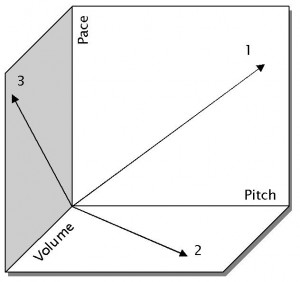By Ewan Pearson
One thing that makes a good voice stand out from an average voice is in how the speaker uses their voice to give emphasis to the content they are presenting. When you hear it, it’s natural but powerful. So what ARE they doing differently?
We have over the past decade conducted many hundreds of voice analyses, either detailed or the quicker short version, for our clients. In each case the resulting scientific report gives us measurements of various – usually 6 or 8 – parameters in their voice, and we use this data to inform our coaching of the vast bulk of our senior clients. These people are the key communicators for their business, so having a good voice is a necessity not an optional extra.
Several of these 6-8 parameters are relevant to vocal emphasis, so we can see clearly from measurements how the voice is (or is not) being used for this all-important indicator of importance.
The three most significant parameters for emphasis are:
- Pitch changes, usually up
- Volume changes, usually louder
- Pace changes, usually slower
These form the basis of the changes that we humans make to add or remove emphasis in the voice.
The key thing here is that emphasis comes from a change in the voice at a specific moment, either at the start of a word, or in the middle of a word.
Emphasis cannot be applied to every syllable or word in a phrase because emphasis varies; the change is what signals it, and you cannot emphasise everything. Or if you do, you sound ridiculous. And probably rude.
These three changes are in a sense dimensions, as they can all be used to varying degrees and each is independent of the other.
They are used by different people in varying ways, and what we usually find is that those who are one-dimensional do not sound as good as those who use two dimensions, who do not sound as good as those who use all three dimensions. Stephen Fry is a good example of someone who uses all dimensions in a rich blend; former Prime Minister Gordon Brown is a good example of a one-dimensional speaker, as he typically used mainly volume for emphasis.
This habit of Gordon Brown’s tended to make him sound unfriendly or aggressive, and it even has a name in scientific circles, the ‘vocal punch’.
Here’s a diagram to show these dimensions; the arrows show changes made in two of the three dimensions of emphasis, which is the most common change:

It’s rather hard to show a fourth line sticking out from the page, so we haven’t, but you get the idea. This would be the line for someone using all three changes – a rise in pitch, a slowing of pace and an increase in volume. That would be the best, and richest sounding combination.
Then there is the distance travelled long each line. Most people that we have coached start by being rather timid in how big a change they will make, but the result is that their attempts to be emphatic are ineffective. Instead they sound rather ‘samey’ all along. This is not to blame them, they usually have never had a voice coaching session before and it has never been a limiting factor in their job. But once they get to the dizzy altitude of the C Suite, it’s a wholly different matter.
The good news is that all this is quite easy to train someone to improve. Yes it requires work, but some simple exercises, usually using their own script or a famous speaker, works quickly and effectively.
If you’re going to ‘try this at home’ (and you can/should, whatever level of speaker you are!), then also use a digital sound recorder (all smart phones have them these days), so that you can concentrate on the sound you’re making when speaking and can review the effect afterwards.
Have a go at each of the numbered alternatives from the 3D diagram, using the same piece of script, then replay them one after the other. You are probably not the best judge of what sounds best, so it is time to enrol a family member or friend. To make things fair, get them to have a go too.
Once the laughing at how you sound is past, reflect on what you’ve just done: consciously you have grabbed your voice by the throat (literally!) and taken some grown-up steps to developing a better voice.
This though is a conscious effort, and was probably quite hard work. It will need practice to develop a sound that is natural and effective and sustainable for you.
So now all you need to do is to read Lynda’s article which follows, in order to develop and then perfect a better voice.

